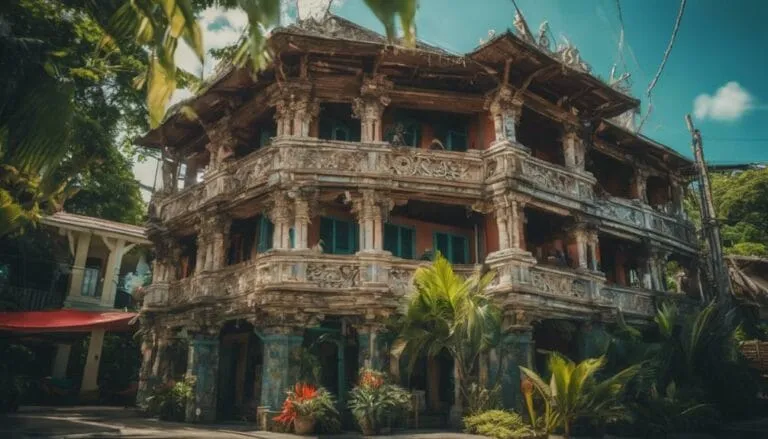Cebu Historical Landmarks
When you explore the historical landmarks of Cebu, you'll uncover a tapestry of stories that span centuries. Imagine standing before Fort San Pedro, the oldest fort in the Philippines, or gazing at Magellan's Cross, a symbol of the country's conversion to Christianity. The Basilica Minore Del Sto. Niño offers a glimpse into the oldest Roman Catholic traditions, while the Yap-Sandiego Ancestral House showcases a blend of Filipino, Spanish, and Chinese architecture. The Heritage of Cebu Monument encapsulates pivotal events in the island's history. So, what makes these sites more than just relics?
Key Takeaways
- Fort San Pedro, built in 1565, is the oldest and smallest fort in the Philippines, showcasing military architecture and historical artifacts.
- Magellan's Cross, planted in 1521, symbolizes the introduction of Christianity and is encased near the Basilica del Santo Niño.
- Basilica Minore Del Sto. Niño, founded in 1565, is the oldest Roman Catholic church in the Philippines, featuring Baroque and Renaissance styles.
- Yap-Sandiego Ancestral House, dating from 1675-1700, displays Filipino, Spanish, and Chinese influences and serves as a living museum.
- The Heritage of Cebu Monument, completed in 2000, captures Cebu's history through sculptures depicting significant historical events.
Fort San Pedro
Fort San Pedro, constructed in 1565, stands as the oldest and smallest fort in the Philippines, originally built for defense against pirates and invaders.
You'll find this historical gem adjacent to Plaza Independencia, offering a unique glimpse into the Spanish colonial period. The fort's triangular shape, robust stone walls, and surrounding moat exemplify the military architecture of the era.
Today, Fort San Pedro serves as a museum, showcasing an array of historical artifacts, including paintings, documents, and sculptures that underline Cebu's rich cultural heritage.
Walking through its halls, you'll encounter remnants of the past that vividly depict the fort's role in protecting Cebu Harbor and its strategic importance during colonial times.
The fort also offers scenic views of Cebu Harbor, providing a serene backdrop that contrasts with its turbulent history.
As you explore, you'll appreciate the fort's significance not just as a military stronghold but as a cultural beacon. The careful preservation of this site allows you to investigate a pivotal chapter of Philippine history, making Fort San Pedro a must-visit for anyone keen to understand Cebu's historical landscape.
Magellan's Cross

While exploring Cebu's historical landmarks, another significant site you'll encounter is Magellan's Cross. Planted by Ferdinand Magellan on March 16, 1521, this cross symbolizes the introduction of Christianity to the Philippines and marks a pivotal event in Cebu's colonization.
Located near the Basilica del Santo Niño, it's encased in a wooden structure within a Spanish-style pavilion, making it a prominent pilgrimage site.
As a National Cultural Treasure, Magellan's Cross reflects the rich religious heritage and historical significance of the area. This landmark doesn't just commemorate the arrival of European explorers but also highlights the cultural exchange between them and the indigenous Filipinos. Such exchanges were foundational in shaping the religious and cultural landscape of Cebu.
Visitors and worshippers alike are drawn to this site, especially during significant religious events. They come to pray, light candles, and reflect on the deep historical and spiritual roots represented by the cross.
Basilica Minore Del Sto. Niño

The Basilica Minore del Sto. Niño, established in 1565, stands as the oldest Roman Catholic church in the Philippines and is home to the revered Santo Niño de Cebu. This basilica, with its rich Baroque and Renaissance architectural styles and neoclassical facade, offers more than just visual appeal; it symbolizes profound historical significance. Recognized as a National Historical Landmark, it plays a pivotal role in Cebu's cultural heritage.
Visitors flock to this pilgrimage site, especially during the annual Sinulog festival in January, celebrating the Santo Niño. Regular masses and various religious activities are held here, reinforcing its status as a cornerstone of Cebu's spiritual life.
| Feature | Details | Significance |
|---|---|---|
| Year Established | 1565 | Oldest Roman Catholic church in PH |
| Architectural Style | Baroque, Renaissance, Neoclassical | Unique and historic |
| Key Relic | Santo Niño de Cebu | Central to religious and cultural life |
| Annual Event | Sinulog festival | Major cultural and religious celebration |
| Designation | National Historical Landmark | Official recognition of its importance |
The basilica's beautifully landscaped garden and historical structures attract both pilgrims and tourists, offering a profound experience of Cebu's spiritual and cultural heritage. A visit here isn't just about sight-seeing; it's a journey into the heart of Cebu.
Yap-Sandiego Ancestral House

Step into the Yap-Sandiego Ancestral House, a historical gem built between 1675 and 1700, and you'll immediately sense the convergence of Filipino, Spanish, and Chinese architectural influences.
As one of the oldest houses in the Philippines, it stands as a representation of the rich heritage of Cebu City. Located in the Parian District, historically a hub for trade and commerce during the Spanish colonial period, the house offers a distinctive glimpse into the past.
Inside, you'll find antique furniture and historical artifacts that reveal the lifestyle of affluent families during the Spanish colonial period. Each piece, meticulously maintained, tells a story of cultural fusion and history.
Guided tours, included with the Php 50 entrance fee, provide a deeper understanding of the house's significance, enhancing your appreciation of this architectural marvel.
Recognized as a National Historical Landmark, the Yap-Sandiego Ancestral House is more than just a preserved structure; it's a living museum that highlights Cebu's rich heritage.
Visiting this house not only immerses you in the past but also underscores the importance of preserving historical landmarks for future generations.
Heritage of Cebu Monument

Located in Parian Plaza, the Heritage of Cebu Monument stands as an intricate tableau of sculptures by artist Eduardo Castrillo, completed in December 2000. This monumental piece captures Cebu's rich history through detailed representations of significant events, such as the Battle of Mactan and the arrival of Christianity. Castrillo's use of concrete, bronze, brass, and steel effectively portrays the various cultural influences that have shaped Cebu.
The monument is not just a visual spectacle but also a popular gathering spot, free to visit, though donations for caretakers are appreciated. The site serves as a cultural hub, attracting both locals and tourists, who come to reflect on Cebu's storied past.
| Feature | Material | Significance |
|---|---|---|
| Battle of Mactan | Bronze, Brass | Marks Cebu's resistance and valor |
| Arrival of Christianity | Concrete, Steel | Symbolizes the spread of faith |
| Cultural Influences | Mixed Media | Reflects diverse historical impacts |
Visiting the Heritage of Cebu Monument offers you a profound glimpse into the island's history, encapsulated through Castrillo's masterful sculptures. Its location in Parian Plaza makes it an accessible and enriching experience, fostering an appreciation for Cebu's rich cultural heritage.
Frequently Asked Questions
What Is the Famous Landmark From Cebu?
You can't miss Magellan's Cross, a landmark planted in 1521, symbolizing Christianity's arrival. Other notable sites include Fort San Pedro, Basilica Minore, Taoist Temple, Heritage of Cebu, Colon Street, Cebu Metropolitan, Lapu Lapu Monument, Cebu Provincial, and Santo Niño.
What Is Cebu Famous For?
You'll find Cebu famous for its vibrant festivals, unique cuisine, and stunning beaches. Explore its rich art and architecture, diverse wildlife, and bustling shopping and nightlife scenes. Efficient transportation and quality education make it truly exceptional.
What Is Historical of Cebu?
You'll find Cebu's history deeply tied to Spanish colonization, evident in its architectural styles and significant religious influence. Historical figures and events shaped trade routes, engaging indigenous peoples. Preservation efforts highlight its rich colonial-era cultural significance.
What Are the Heritage Sites in Cebu?
You'll find Cebu churches like Basilica Minore del Santo Niño, historic Fort San Pedro, Magellan's Cross, Taoist Temple, Cebu ancestral houses, Colon Street, Lapu Lapu Shrine, Cebu Provincial Capitol, Heritage of Cebu, and Balay Ni Mayang.
Conclusion
You've just scratched the surface of Cebu's rich history by exploring landmarks like Fort San Pedro, Magellan's Cross, the Basilica Minore Del Sto. Niño, the Yap-Sandiego Ancestral House, and the Heritage of Cebu Monument. Each site offers a unique glimpse into the city's colonial past and vibrant cultural heritage. By visiting these sites, you'll gain a deeper understanding of Cebu's complex history and the diverse influences that have shaped it over centuries. Don’t miss the opportunity to further immerse yourself in Cebu’s history by visiting its national museum. Cebu’s national museum exhibits an extensive collection of artifacts, artworks, and historical items that shed light on the city’s past. With so much to see and learn, a visit to Cebu’s national museum is a must for anyone interested in delving deeper into the rich tapestry of Cebu’s history. For a more in-depth exploration of Cebu’s rich history, consider visiting the Cebu National Museum. Here, you can delve into the extensive collection of Cebu national museum artifacts, including pre-colonial artifacts, religious relics, and artworks that offer further insight into the city’s cultural evolution. By immersing yourself in these historical treasures, you’ll gain a deeper appreciation for Cebu’s storied past and the enduring legacy of its diverse cultural influences.







